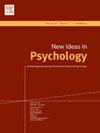反事实的想象文化作为支持减少焦虑的幻觉证据
IF 2.9
3区 心理学
Q2 PSYCHOLOGY, EXPERIMENTAL
引用次数: 0
摘要
为什么人类要投入精力去创造不存在的、不能被证明存在的、或因文化习俗而存在的物体和情境的表征?本研究通过将反事实文化生产确定为证据幻觉的一种形式,为这一现象提供了一种解释,在这种幻觉中,通过向感知环境中注入关于其真实性的捏造证据,使减少焦虑的文化和认知模型成为“真实的”。理论框架建立在信息论、热力学和主动推理方法的概念上,以实现代理与环境的相互作用;它受到了两种文化现象的考验——詹姆斯国王版(KJV)圣经的四福音书中所阐述的宗教福音主义和国旗形式的集体身份象征。第一项研究利用感觉运动关联将英语单词编码为64个类别,并预测KJV应该通过从每个感觉类别中过度取样具有大语义大小的正价值单词来解决存在焦虑——这样做,产生一个内隐的世界模型,其不可预测性低于背景英语。第二项研究预测,国旗的视觉熵与内源性焦虑(集体担心内部冲突)呈正相关,而内部对比与外源性焦虑(集体担心外部威胁)呈负相关,对比度锚定熵处于低对比度位置。这些研究与一种观点(但没有证明)是一致的,即使用简单的形式主义,无需人类认知的“厚”模型,就可以从情感倾向中预测高水平文化活动的详细特征。本文章由计算机程序翻译,如有差异,请以英文原文为准。
Counterfactual imaginative culture as evidence hallucination in support of anxiety reduction
Why do human beings invest work in creating representations of objects and situations that do not exist, cannot be proven to exist, or exist by cultural convention? This study offers an explanation of this phenomenon by identifying counterfactual cultural production as a form of evidence hallucination, where anxiety-reducing cultural and cognitive models are made to be ‘true’ by flooding the perceptual environment with fabricated evidence of their truth. The theoretical framework builds on concepts from information theory, thermodynamics, and active-inference approaches to agent—environment interactions; it is tested against two cultural phenomena—religious evangelism as articulated in the four Gospels of the King James Version (KJV) Bible and symbols of collective identity in the form of national flags. The first study encodes English words into 64 categories using their sensorimotor associations, and predicts that the KJV should address existential anxiety by over-sampling positively valenced words with large semantic size from each sensory category—and in doing so, generate an implicit world-model that is lower in unpredictability than that of background English. The second study predicts that the visual entropy of national flags will positively scale with endogenous anxiety (collective worry about internal conflict) and that internal contrast will negatively scale with exogenous anxiety (collective worry about external threats)—with contrast anchoring entropy in the low contrast position. These studies are consistent with the view (but do not prove) that it is possible to predict detailed features of high-level cultural activity from affective dispositions using a straightforward formalism and without a ‘thick’ model of human cognition.
求助全文
通过发布文献求助,成功后即可免费获取论文全文。
去求助
来源期刊

New Ideas in Psychology
Multiple-
CiteScore
4.80
自引率
3.80%
发文量
37
期刊介绍:
New Ideas in Psychology is a journal for theoretical psychology in its broadest sense. We are looking for new and seminal ideas, from within Psychology and from other fields that have something to bring to Psychology. We welcome presentations and criticisms of theory, of background metaphysics, and of fundamental issues of method, both empirical and conceptual. We put special emphasis on the need for informed discussion of psychological theories to be interdisciplinary. Empirical papers are accepted at New Ideas in Psychology, but only as long as they focus on conceptual issues and are theoretically creative. We are also open to comments or debate, interviews, and book reviews.
 求助内容:
求助内容: 应助结果提醒方式:
应助结果提醒方式:


